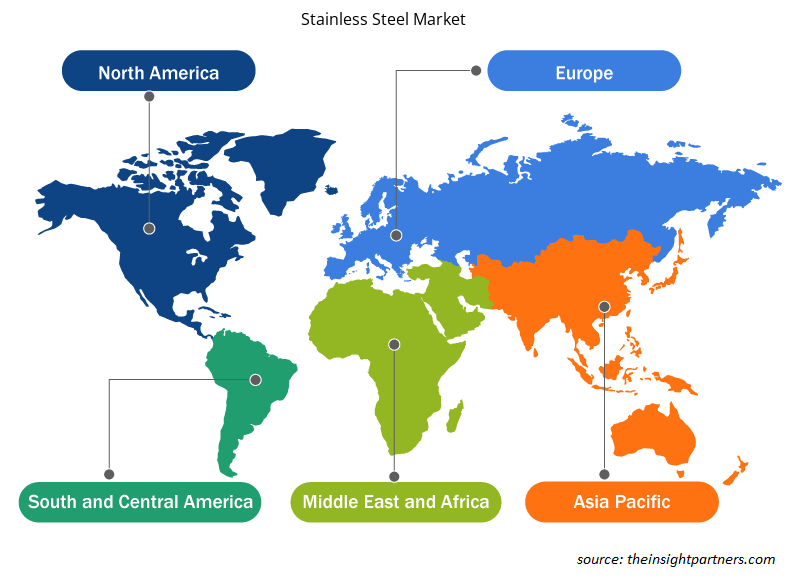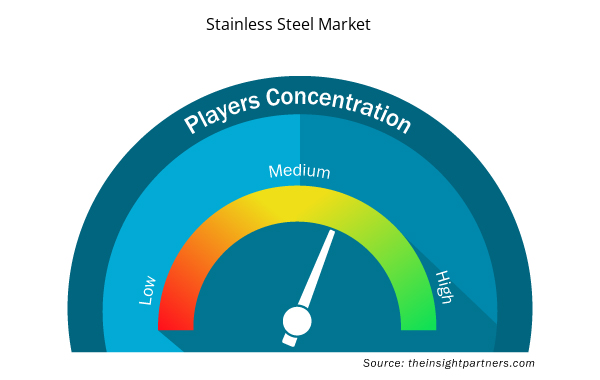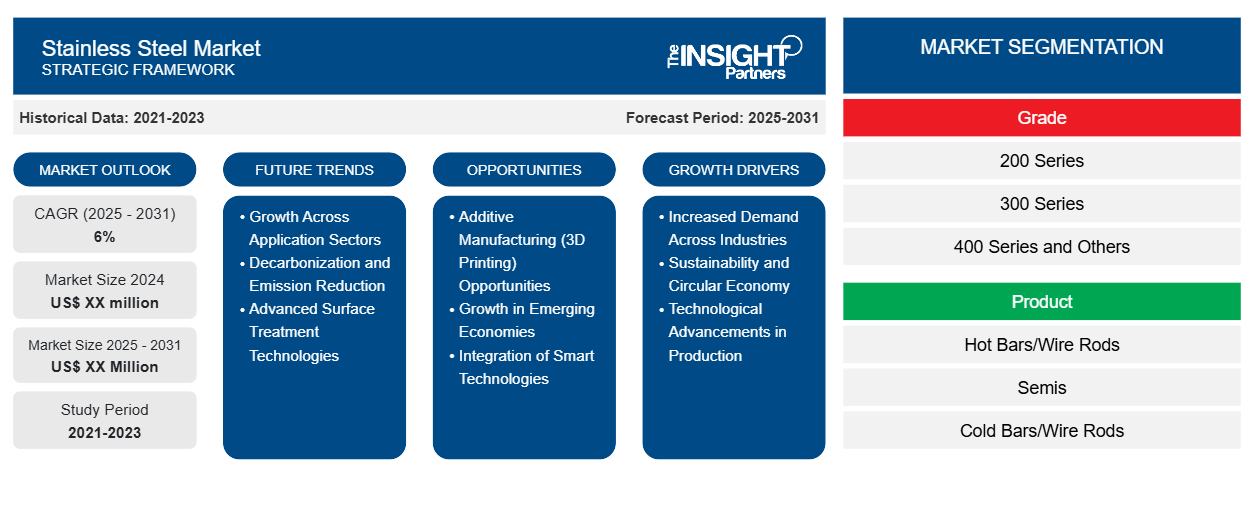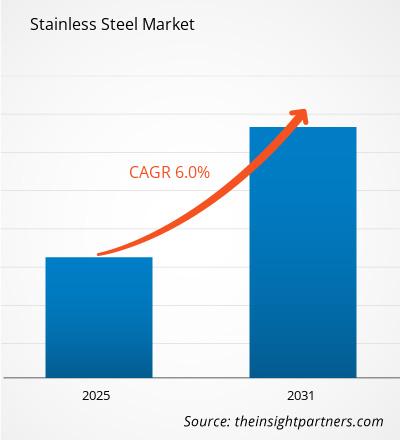Es wird erwartet, dass der Edelstahlmarkt von 2023 bis 2031 eine durchschnittliche jährliche Wachstumsrate (CAGR) von 6 % verzeichnet und dass die Marktgröße von XX Millionen US-Dollar im Jahr 2023 auf XX Millionen US-Dollar im Jahr 2031 anwächst.
Der Bericht ist nach Güteklasse (200er-Serie, 300er-Serie, 400er-Serie und andere) und Produkt (Warmstäbe/Walzdraht, Halbzeug, Kaltstäbe/Walzdraht, Warmspulen, Warmplatten und -bleche und kaltgewalztes Flachmaterial) segmentiert. Der Bericht präsentiert außerdem Analysen basierend auf der Anwendung (Automobil und Transport, Bauwesen, Konsumgüter, Schwerindustrie, Elektromaschinen und andere). Die globale Analyse ist weiter auf regionaler Ebene und in die wichtigsten Länder unterteilt. Die Marktgröße und -prognose auf globaler, regionaler und Länderebene für alle wichtigen Marktsegmente werden im Rahmen des Berichts abgedeckt. Der Bericht bietet den Wert in USD für die oben genannte Analyse und die Segmente. Der Bericht bietet wichtige Statistiken zum Marktstatus der wichtigsten Marktteilnehmer und bietet Markttrends und -chancen.
Zweck des Berichts
Der Bericht „Edelstahlmarkt“ von The Insight Partners soll die aktuelle Situation und das zukünftige Wachstum sowie die wichtigsten treibenden Faktoren, Herausforderungen und Chancen beschreiben. Dies wird verschiedenen Geschäftspartnern Einblicke geben, wie zum Beispiel:
- Technologieanbieter/-hersteller: Um die sich entwickelnde Marktdynamik zu verstehen und die potenziellen Wachstumschancen zu kennen, damit sie fundierte strategische Entscheidungen treffen können.
- Investoren: Durchführung einer umfassenden Trendanalyse hinsichtlich der Marktwachstumsrate, der finanziellen Marktprognosen und der Chancen entlang der Wertschöpfungskette.
- Regulierungsbehörden: Sie regulieren Richtlinien und polizeiliche Maßnahmen auf dem Markt mit dem Ziel, Missbrauch zu minimieren, das Vertrauen der Anleger zu bewahren und die Integrität und Stabilität des Marktes aufrechtzuerhalten.
Edelstahl-Marktsegmentierung
Grad
- Serie 200
- Serie 300
- Serie 400 und andere
Produkt
- Warmstäbe/Walzdrähte
- Halbfinale
- Kaltgewalzte Stangen/Drahtstäbe
- Heiße Spulen
- Warmbleche und kaltgewalzte Flachprodukte
Anwendung
- Automobil und Transport
- Bauwesen
- Konsumgüter
- Schwerindustrie
- Elektrische Maschinen und Sonstiges
Geographie
- Nordamerika
- Europa
- Asien-Pazifik
- Süd- und Mittelamerika
- Naher Osten und Afrika
Geographie
- Nordamerika
- Europa
- Asien-Pazifik
- Süd- und Mittelamerika
- Naher Osten und Afrika
Passen Sie diesen Bericht Ihren Anforderungen an
Sie erhalten kostenlose Anpassungen an jedem Bericht, einschließlich Teilen dieses Berichts oder einer Analyse auf Länderebene, eines Excel-Datenpakets sowie tolle Angebote und Rabatte für Start-ups und Universitäten.
- Holen Sie sich die wichtigsten Markttrends aus diesem Bericht.Dieses KOSTENLOSE Beispiel umfasst eine Datenanalyse von Markttrends bis hin zu Schätzungen und Prognosen.
Wachstumstreiber auf dem Edelstahlmarkt
- Steigende Nachfrage in allen Branchen: Der gestiegene Verbrauch von Edelstahl in verschiedenen Endverbrauchsbranchen wie Bauwesen, Automobilbau und Konsumgütern hat sich als wichtiger Treiber für den Edelstahlmarkt herausgestellt. Unter diesen verzeichnet die Baubranche aufgrund der Urbanisierung und der Entwicklung der Infrastruktur eine vielversprechende Wachstumskurve, die wiederum immer mehr Edelstahl für Gebäude, Dächer und Fassaden benötigt. In ähnlicher Weise profitiert auch die Automobilbranche von Edelstahl aufgrund der Haltbarkeit und Korrosionsbeständigkeit des Materials, was letztendlich zur Haltbarkeit und Leistung der Fahrzeuge beiträgt.
- Nachhaltigkeit und Kreislaufwirtschaft: Alle Branchen bemühen sich zunehmend um die Einhaltung nachhaltiger Entwicklungsnormen, wobei die Hersteller stärker auf umweltfreundliche Praktiken setzen. Edelstahl wird wiederverwendet; daher ist er auch Teil der globalen Abfallreduzierungsagenda und verbindet Wertschöpfungsketten der Kreislaufwirtschaft. Mit zunehmender Regulierung mit strengeren Standards in Bezug auf Emissionen und Materialeinsatz werden die Branchen weiterhin auf nachhaltige Alternativen wie Edelstahl umsteigen und den Verbrauch steigern.
- Technologische Fortschritte in der Produktion: Verbesserungen bei Schmelz- und Raffinationsprozessen sowie neuere Fertigungstechnologien steigern die Effizienz und Qualität bei der Herstellung von Edelstahl. So hat beispielsweise die Technologie des Lichtbogenofens (EAF) die Produktionsmethoden nachhaltiger gemacht, da bei der Stahlherstellung weniger Energie benötigt wird und weniger Emissionen entstehen. Dies hat die Produktionskosten gesenkt und die Produktqualität verbessert, was sie für den Endverbraucher wertvoller macht.
Zukünftige Trends auf dem Edelstahlmarkt
- Wachstum in allen Anwendungsbereichen: Die Verwendung von Edelstahl in der Industrie boomt. Dies liegt an den bereits erwähnten Eigenschaften wie Korrosionsbeständigkeit, Festigkeit und Schönheit. Diese Eigenschaften führen zu einer breiteren Verwendung in den Bereichen Bau, Automobil, Lebensmittelverarbeitung und Konsumgüter, in denen Haltbarkeit, Sicherheit und Ästhetik wichtig sein können.
- Dekarbonisierung und Emissionsreduzierung: Der Druck der Stahlindustrie zur Kohlenstoffreduzierung steigt mit der Dekarbonisierung und Emissionsreduzierung in der Produktion. Zu den neuen Wegen, die Unternehmen erkunden, um ihre Emissionen bei der Herstellung von Edelstahl zu reduzieren, gehören die Nutzung erneuerbarer Energiequellen und die Installation von Technologien zur Kohlenstoffabscheidung. Es handelt sich dabei nicht nur um eine bloße regulatorische Forderung, sondern auch um eine Entsprechung der Erwartungen der Verbraucher an umweltfreundliche Produkte.
- Fortschrittliche Oberflächenbehandlungstechnologien: Elektropolieren und andere fortschrittliche Oberflächenbehandlungstechnologien gewinnen immer mehr an Bedeutung, um die Leistung und Ästhetik von Edelstahlprodukten zu verbessern. Verbesserte Korrosionsbeständigkeit, Oberflächenbeschaffenheit und Ästhetik machen Edelstahl zu einer attraktiven Option für Anwendungen in der Lebensmittelverarbeitung, Pharmazie und hochwertigen Konsumgütern. Dieser Trend spiegelt das Engagement der Branche für Qualität und Leistung wider.
Marktchancen für Edelstahl
- Möglichkeiten der additiven Fertigung (3D-Druck): Die Einführung der additiven Fertigung (3D-Druck) eröffnet der Edelstahlindustrie enorme Möglichkeiten. Die Technologie zeichnet sich durch die Herstellung einzigartiger Geometrien und komplexer, maßgeschneiderter Komponenten nach langjährigem Einsatz mit herkömmlichen Fertigungsverfahren aus. Da die Industrie nach produktiveren und flexibleren Produktionsmethoden sucht, können sie mit Edelstahl neue Einsatzmöglichkeiten und Bergbaunischen erschließen.
- Wachstum in Schwellenländern: Die Schwellenländer bewegen sich rasch in Richtung Industrialisierung und Urbanisierung, was für Hersteller von rostfreiem Stahl heiße Gelegenheiten schafft. Während diese Märkte wachsen und sich weiterentwickeln, werden sich die Konsummuster proportional ändern und die Nachfrage nach rostfreiem Stahl in den Bereichen Bau, Automobil und Konsumgüter stark ansteigen. Unternehmen, die sich jetzt in diesen Bereichen niederlassen, könnten von diesem Boom profitieren und sich einen beträchtlichen Marktanteil sichern.
- Integration intelligenter Technologien: Intelligente Technologien wie IoT und KI können in die Produktionsprozesse von Edelstahl integriert werden. Ihre Anwendung wird die Abläufe verbessern und die Qualität der Produkte steigern. Hersteller werden ihre Produktionslinien mithilfe von Datenanalysen, Abfallminimierung und verbessertem Lieferkettenmanagement optimieren. Diese Verbesserung der Prozesstechnologie wird zu höherer Produktivität und einer besseren Reaktionsfähigkeit auf die Marktnachfrage und Verbraucherpräferenzen führen, indem die Vorlaufzeiten verkürzt werden.
Regionale Einblicke in den Edelstahlmarkt
Die regionalen Trends und Faktoren, die den Edelstahlmarkt im Prognosezeitraum beeinflussen, wurden von den Analysten von Insight Partners ausführlich erläutert. In diesem Abschnitt werden auch die Edelstahlmarktsegmente und die Geografie in Nordamerika, Europa, im asiatisch-pazifischen Raum, im Nahen Osten und Afrika sowie in Süd- und Mittelamerika erörtert.

- Erhalten Sie regionale Daten zum Edelstahlmarkt
Umfang des Edelstahlmarktberichts
| Berichtsattribut | Details |
|---|---|
| Marktgröße im Jahr 2023 | XX Millionen US-Dollar |
| Marktgröße bis 2031 | XX Millionen US-Dollar |
| Globale CAGR (2023 - 2031) | 6 % |
| Historische Daten | 2021-2022 |
| Prognosezeitraum | 2024–2031 |
| Abgedeckte Segmente | Nach Klasse
|
| Abgedeckte Regionen und Länder | Nordamerika
|
| Marktführer und wichtige Unternehmensprofile |
|
Marktdichte von Edelstahl: Auswirkungen auf die Geschäftsdynamik verstehen
Der Markt für Edelstahl wächst rasant, angetrieben durch die steigende Nachfrage der Endverbraucher aufgrund von Faktoren wie sich entwickelnden Verbraucherpräferenzen, technologischen Fortschritten und einem größeren Bewusstsein für die Vorteile des Produkts. Mit steigender Nachfrage erweitern Unternehmen ihr Angebot, entwickeln Innovationen, um die Bedürfnisse der Verbraucher zu erfüllen, und nutzen neue Trends, was das Marktwachstum weiter ankurbelt.
Die Marktteilnehmerdichte bezieht sich auf die Verteilung der Firmen oder Unternehmen, die in einem bestimmten Markt oder einer bestimmten Branche tätig sind. Sie gibt an, wie viele Wettbewerber (Marktteilnehmer) in einem bestimmten Marktraum im Verhältnis zu seiner Größe oder seinem gesamten Marktwert präsent sind.
Die wichtigsten auf dem Edelstahlmarkt tätigen Unternehmen sind:
- Acerinox SA
- Aperam SA
- ArcelorMittal SA
- Jindal Stainless Limited.
- Outokumpu OYJ
Haftungsausschluss : Die oben aufgeführten Unternehmen sind nicht in einer bestimmten Reihenfolge aufgeführt.

- Überblick über die wichtigsten Akteure auf dem Edelstahlmarkt
Wichtige Verkaufsargumente
- Umfassende Abdeckung: Der Bericht deckt die Analyse von Produkten, Dienstleistungen, Typen und Endbenutzern des Edelstahlmarktes umfassend ab und bietet einen ganzheitlichen Überblick.
- Expertenanalyse: Der Bericht basiert auf dem umfassenden Verständnis von Branchenexperten und Analysten.
- Aktuelle Informationen: Der Bericht stellt durch die Abdeckung aktueller Informationen und Datentrends Geschäftsrelevanz sicher.
- Anpassungsoptionen: Dieser Bericht kann angepasst werden, um spezifische Kundenanforderungen zu erfüllen und die Geschäftsstrategien optimal anzupassen.
Der Forschungsbericht zum Edelstahlmarkt kann daher dabei helfen, die Branchensituation und Wachstumsaussichten zu entschlüsseln und zu verstehen. Obwohl es einige berechtigte Bedenken geben kann, überwiegen die allgemeinen Vorteile dieses Berichts tendenziell die Nachteile.
- Historische Analyse (2 Jahre), Basisjahr, Prognose (7 Jahre) mit CAGR
- PEST- und SWOT-Analyse
- Marktgröße Wert/Volumen – Global, Regional, Land
- Branche und Wettbewerbsumfeld
- Excel-Datensatz



Report Coverage
Revenue forecast, Company Analysis, Industry landscape, Growth factors, and Trends

Segment Covered
This text is related
to segments covered.

Regional Scope
North America, Europe, Asia Pacific, Middle East & Africa, South & Central America

Country Scope
This text is related
to country scope.
Häufig gestellte Fragen
Increased focus on eletropolishing and surface treatments is expected to be the key market trends
The report can be delivered in PDF/Word format, we can also share excel data sheet based on request.
On the basis of geography, the stainless steel market is classified into North America, Europe, Asia Pacific, Middle East and Africa, and South and Central America
Acerinox S.A.; Aperam; ArcelorMittal; Jindal Stainless Ltd; Sandmeyer Steel Company; Sandvik AB are some of the key players operating in the stainless steel market
Sustainability and environmental regulations is driving the market growth
The Stainless Steel Market is estimated to witness a CAGR of 6% from 2023 to 2031
Trends and growth analysis reports related to Chemicals and Materials : READ MORE..
The List of Companies
- Acerinox S.A
- Aperam S.A.
- ArcelorMittal S.A
- Jindal Stainless Limited.
- Outokumpu OYJ
- Sandmeyer Steel Company
- Sandvik AB.
- Schmolz + Bickenbach Group
- Thyssenkrupp AG
- Guangxi Chengdu Group
The Insight Partners performs research in 4 major stages: Data Collection & Secondary Research, Primary Research, Data Analysis and Data Triangulation & Final Review.
- Data Collection and Secondary Research:
As a market research and consulting firm operating from a decade, we have published and advised several client across the globe. First step for any study will start with an assessment of currently available data and insights from existing reports. Further, historical and current market information is collected from Investor Presentations, Annual Reports, SEC Filings, etc., and other information related to company’s performance and market positioning are gathered from Paid Databases (Factiva, Hoovers, and Reuters) and various other publications available in public domain.
Several associations trade associates, technical forums, institutes, societies and organization are accessed to gain technical as well as market related insights through their publications such as research papers, blogs and press releases related to the studies are referred to get cues about the market. Further, white papers, journals, magazines, and other news articles published in last 3 years are scrutinized and analyzed to understand the current market trends.
- Primary Research:
The primarily interview analysis comprise of data obtained from industry participants interview and answers to survey questions gathered by in-house primary team.
For primary research, interviews are conducted with industry experts/CEOs/Marketing Managers/VPs/Subject Matter Experts from both demand and supply side to get a 360-degree view of the market. The primary team conducts several interviews based on the complexity of the markets to understand the various market trends and dynamics which makes research more credible and precise.
A typical research interview fulfils the following functions:
- Provides first-hand information on the market size, market trends, growth trends, competitive landscape, and outlook
- Validates and strengthens in-house secondary research findings
- Develops the analysis team’s expertise and market understanding
Primary research involves email interactions and telephone interviews for each market, category, segment, and sub-segment across geographies. The participants who typically take part in such a process include, but are not limited to:
- Industry participants: VPs, business development managers, market intelligence managers and national sales managers
- Outside experts: Valuation experts, research analysts and key opinion leaders specializing in the electronics and semiconductor industry.
Below is the breakup of our primary respondents by company, designation, and region:

Once we receive the confirmation from primary research sources or primary respondents, we finalize the base year market estimation and forecast the data as per the macroeconomic and microeconomic factors assessed during data collection.
- Data Analysis:
Once data is validated through both secondary as well as primary respondents, we finalize the market estimations by hypothesis formulation and factor analysis at regional and country level.
- Macro-Economic Factor Analysis:
We analyse macroeconomic indicators such the gross domestic product (GDP), increase in the demand for goods and services across industries, technological advancement, regional economic growth, governmental policies, the influence of COVID-19, PEST analysis, and other aspects. This analysis aids in setting benchmarks for various nations/regions and approximating market splits. Additionally, the general trend of the aforementioned components aid in determining the market's development possibilities.
- Country Level Data:
Various factors that are especially aligned to the country are taken into account to determine the market size for a certain area and country, including the presence of vendors, such as headquarters and offices, the country's GDP, demand patterns, and industry growth. To comprehend the market dynamics for the nation, a number of growth variables, inhibitors, application areas, and current market trends are researched. The aforementioned elements aid in determining the country's overall market's growth potential.
- Company Profile:
The “Table of Contents” is formulated by listing and analyzing more than 25 - 30 companies operating in the market ecosystem across geographies. However, we profile only 10 companies as a standard practice in our syndicate reports. These 10 companies comprise leading, emerging, and regional players. Nonetheless, our analysis is not restricted to the 10 listed companies, we also analyze other companies present in the market to develop a holistic view and understand the prevailing trends. The “Company Profiles” section in the report covers key facts, business description, products & services, financial information, SWOT analysis, and key developments. The financial information presented is extracted from the annual reports and official documents of the publicly listed companies. Upon collecting the information for the sections of respective companies, we verify them via various primary sources and then compile the data in respective company profiles. The company level information helps us in deriving the base number as well as in forecasting the market size.
- Developing Base Number:
Aggregation of sales statistics (2020-2022) and macro-economic factor, and other secondary and primary research insights are utilized to arrive at base number and related market shares for 2022. The data gaps are identified in this step and relevant market data is analyzed, collected from paid primary interviews or databases. On finalizing the base year market size, forecasts are developed on the basis of macro-economic, industry and market growth factors and company level analysis.
- Data Triangulation and Final Review:
The market findings and base year market size calculations are validated from supply as well as demand side. Demand side validations are based on macro-economic factor analysis and benchmarks for respective regions and countries. In case of supply side validations, revenues of major companies are estimated (in case not available) based on industry benchmark, approximate number of employees, product portfolio, and primary interviews revenues are gathered. Further revenue from target product/service segment is assessed to avoid overshooting of market statistics. In case of heavy deviations between supply and demand side values, all thes steps are repeated to achieve synchronization.
We follow an iterative model, wherein we share our research findings with Subject Matter Experts (SME’s) and Key Opinion Leaders (KOLs) until consensus view of the market is not formulated – this model negates any drastic deviation in the opinions of experts. Only validated and universally acceptable research findings are quoted in our reports.
We have important check points that we use to validate our research findings – which we call – data triangulation, where we validate the information, we generate from secondary sources with primary interviews and then we re-validate with our internal data bases and Subject matter experts. This comprehensive model enables us to deliver high quality, reliable data in shortest possible time.


 Holen Sie sich ein kostenloses Muster für diesen Bericht
Holen Sie sich ein kostenloses Muster für diesen Bericht